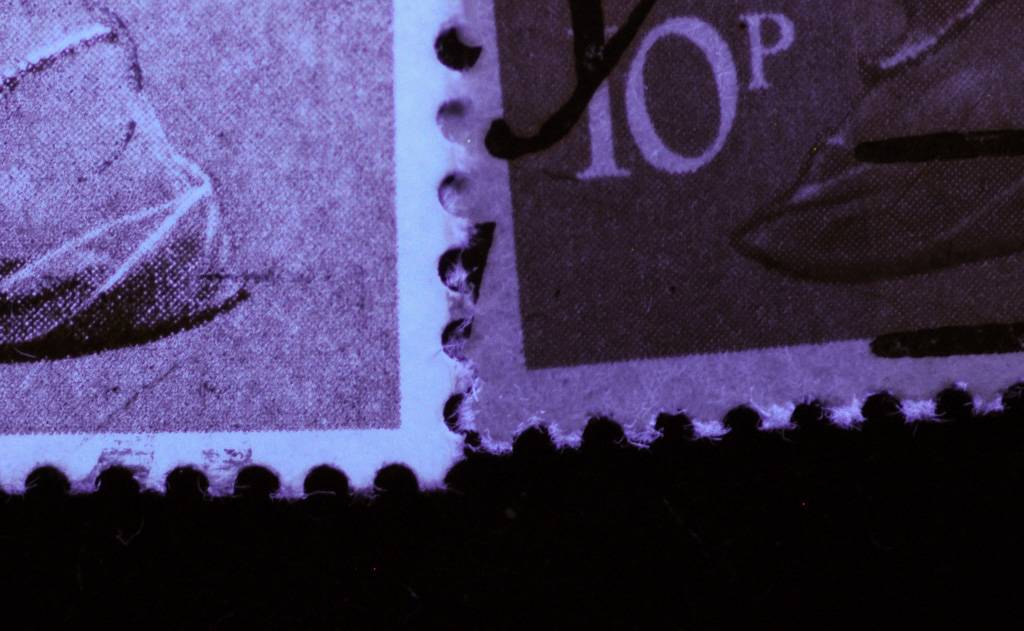angore
Member 
Posts: 5,696  What I collect: WW, focus on British Empire
What I collect: WW, focus on British Empire
|
Post by angore on Apr 19, 2019 21:09:19 GMT
Here is the one I did not fully make sense until this identification supposedly settled it. I am working with the 10p orangish ones. I have a 10p that has narrow value and no bars so has to be X940. This means the tagging (not actual X940 but same reaction under SW light) on the right has to be phosphorized paper. So example on left has to be "allover" since no bars. It is much more reactive under SW UV. The left image also looks like some phosphorized paper so other than scratching the stamp how do you determine allover tagging. It looks like some phosphor paper. Image under SW UV light.  |
|
angore
Member 
Posts: 5,696  What I collect: WW, focus on British Empire
What I collect: WW, focus on British Empire
|
Post by angore on Apr 20, 2019 13:33:18 GMT
Update. While working on the 50p with standard perforations, I found varieties printed on ordinary paper (no phosphor per SG since not 2Band) that look similar under UV light. Using adminware Machin site these have fluorescent coated paper) (FCP) under UV so what I see on right is this coating. This means it does not to include phosphor if I understand it correctly. Now, I need to see if PCP and FCP look visually other than just assessing the reaction under UV.
|
|
Ryan
Moderator  Calgary, Alberta, Canada
Calgary, Alberta, Canada
Posts: 2,749  What I collect: If I have a catalogue for it, I collect it. And I have many catalogues ....
What I collect: If I have a catalogue for it, I collect it. And I have many catalogues ....
|
Post by Ryan on Apr 20, 2019 23:19:27 GMT
And remember that phosphorescence is different from fluorescence - a fluorescent coating / tagging is intended to be reactive while the UV light is turned on, whereas phosphorescence is intended to use the afterglow which is active after the light is turned off (even though you can often see some amount of glowing while the light is on). When I'm checking phosphorescence, I often keep my eyes closed while the UV light is on, only opening them after I turn the light off. Sometimes I can cheat and see some glow in the taggant while the light is on, but not always.
I usually check a bunch of stamps at once so I'll lay a grid of them on the table - any phosphorescent stamps I can identify while the UV light is on are then picked out, leaving me with only the tricky ones, and that's when I start closing my eyes to identify the rest. A very dark room is often necessary, to the point where I do lots of my UV work in a room with no windows with the lights turned off. Like you, I pretty much have only used Machins, I've never bought mint ones. I do have plenty of Winnipeg-tagged Canadian stamps in mint and they're very easy to identify, but in any case those are much less of a problem to identify when they've been used & soaked compared to Machins, it seems.
Ryan
|
|
angore
Member 
Posts: 5,696  What I collect: WW, focus on British Empire
What I collect: WW, focus on British Empire
|
Post by angore on Apr 21, 2019 10:42:25 GMT
Yes, I know the difference between phosphorescence and fluorescence. Under shortwave UV, phosphors will react at the same time too but the phosphorescent after glow will persist. In the question above, I was looking for a more definitive method to declare a stamp with allover tagging. There are only a few since it was a transition tagging method.
I have been actually trying to capture the effect in a video.
|
|
wakeybluenose
Member  Mostly harmless!
Mostly harmless!
Posts: 311  What I collect: GB to 2000 (but definitives to date) / Ireland to 2000 / General WW classics & definitives / ASFEC / SciFi & Fantasy Literature / Local History
What I collect: GB to 2000 (but definitives to date) / Ireland to 2000 / General WW classics & definitives / ASFEC / SciFi & Fantasy Literature / Local History
|
Post by wakeybluenose on May 16, 2021 14:09:28 GMT
I'd like to resurrect this thread to see if any further light has been shed on this issue (pun intended).
I've spent a lot of time over this weekend sorting and cataloguing Machins.
Is there any way for me to tell the difference between 'all-over' phosphor and phosphorised paper... Eg the 1p crimson; X846 and X925 both catalogue at 20p suggesting that they are both as prevelent as each other, however the big pile of them in front of me look no different under the (admittedly cheap) UV torch I have!
Is there a way of differentiating between them with minimal tools?
|
|
angore
Member 
Posts: 5,696  What I collect: WW, focus on British Empire
What I collect: WW, focus on British Empire
|
Post by angore on May 16, 2021 18:05:23 GMT
The Machin head image looks coarser under normal light with the all over (applied on top) compared to phosphored paper, Left: AOP Right: phosphor paper  I checked Deegam and AOP was only available with T1/B1 (value type, head type) while the phosphor paper was available in T1B1, T1a+/B2, and T4/B2 so cannot isolate using that aspect (both had T1/B1). |
|